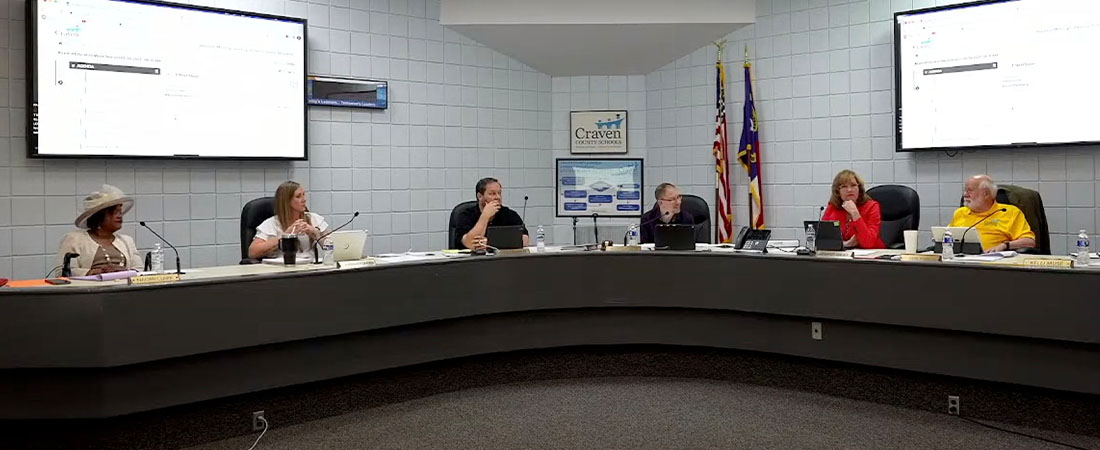
The Craven County Board of Education could take action on the school district’s 2024-25 redistricting plan by December, according to a presentation at the board’s August 15 meeting. The board acknowledged that the lengthy process will likely lead to changes in the path students take as they move up through the school system.
Mike Miller from Numerix, LLC, the school system’s redistricting consultant, explained that the board would need to have a first draft of its student reassignment plan in place by late September or early October and a revised second edition approved by November. He said that timeline would allow the board to approve the final redistricting plan the following month. The board would also need to schedule dates for community input sessions.
The board agreed to hold a special called meeting in September to address the redistricting plan.
“Your staff has a whole lot of work to do after the board makes these decisions in transportation and facilities to prepare for these changes,” Miller said.
Miller noted that the school system’s student assignment objectives are to provide relief to over-crowded schools, balance utilization among existing schools, maintain feeder patterns, and minimize the number of students moved.
Miller said the process of crafting new attendance areas for 2024-25 will involve a GIS (Geographic Information Systems) database analysis of student data, current school boundaries, streets, water features and other relevant data.
He said the information will also include the locations of new subdivisions.
“In my experience the big drivers of student growth are the larger subdivisions, typically they would attract younger families with school age children,” Miller commented. “That’s where you see the biggest jump in student growth.”
Miller explained that one of the main drivers in the redistricting process would be achieving a balance in the utilization of all school system facilities.
“For example, can you always send kids to the nearest school? In Craven County that’s almost impossible because of the water. Secondly, if you always send kids to the closest school chances are you’re going to have schools that are very, very crowded in densely packed areas and practically empty elsewhere,” Miller noted.
According to data provided by Numerix, the overall Craven County Schools student population has decreased by about 243 students per year over the last six years. He said in 2022 the average daily membership (ADM) increased by 177 over the previous year, showing some signs of reversal.
Miller said any plan that seeks to balance facility utilization will likely impact the current feeder school system. He offered a breakdown of the school system’s utilization patterns, which vary widely throughout the county:
-West Craven District Feeder Pattern: Ranges from Vanceboro-Farm Life Elementary at 101% program utility to James W Smith Elementary at 70%.
-New Bern District Feeder Pattern: Ranges from Albert H Bangert Elementary at 135% program utility to Brinson Memorial ES at 63%.
-Havelock Area: The maximum is Roger Bell Academy at 129% program utility and the minimum is Havelock Middle School at 72%.
Miller said feeder patterns are often “one of the first casualties” in redistricting.
“In my opinion a successful student assignment plan matches the priorities that the board deems are important and should always try to maintain feeder patterns for a sense of stability for the families and should always try to minimize the number of students moved and try to send the kids to the closest school, “Miller said. “Somewhere along the line some of those break. So that’s what we’re up against.”
Board member Jennifer Dacey said she agreed that feeder patterns may have to be adjusted.
“Given the massive growth that I think we’re likely to see in James City we may have no option but to look at adjusting those,” she said. “I just think we have to put that out there…I think we have to be open to doing some things differently.”
Miller said a decision on whether to consolidate certain schools will have to be decided at an early stage of the redistricting process.
“It essentially puts you back at square one…if the goal is to repurpose schools and consolidate those populations into other schools then that changes everything,” he commented.
Board member Kelli Muse acknowledged that the redistricting process would involve difficult decisions.
“This isn’t going to be pleasant. This is probably going to be some of the hardest work that we’ve ever done and everybody’s going to get upset,” she said. “So it’s really important that we put it out there that we’re not trying to make anybody upset or angry, we’re trying to utilize our facilities in the best possible way which will afford us the opportunity to do some upgrades.”
By Todd Wetherington, co-editor. Send an email with questions or comments.

